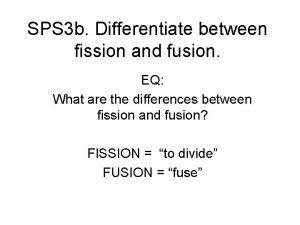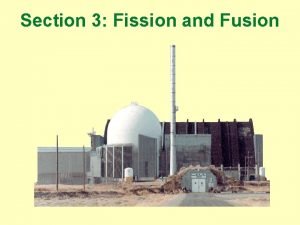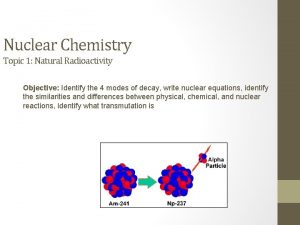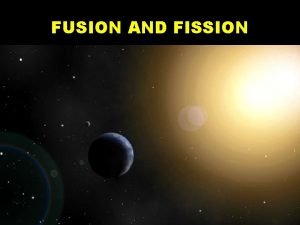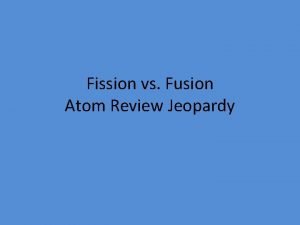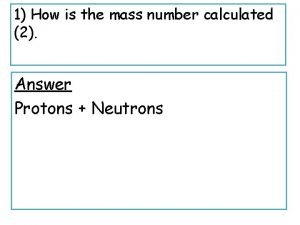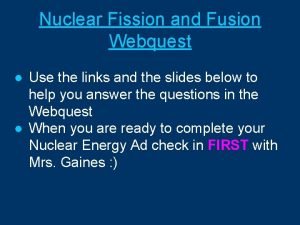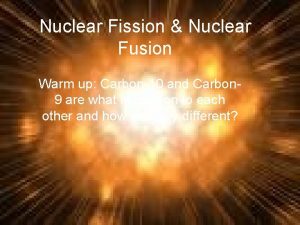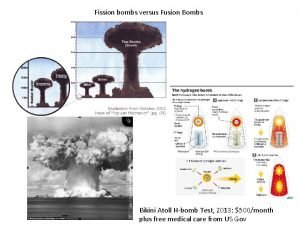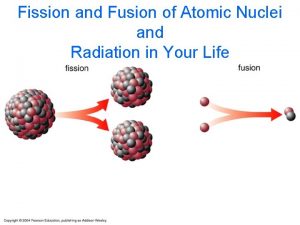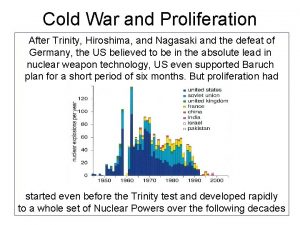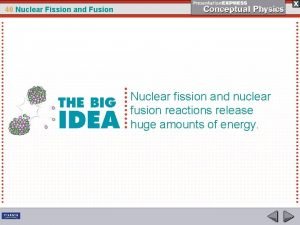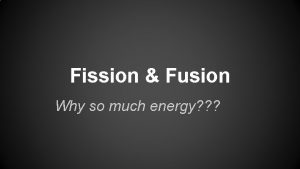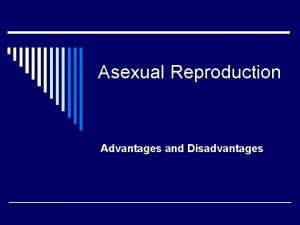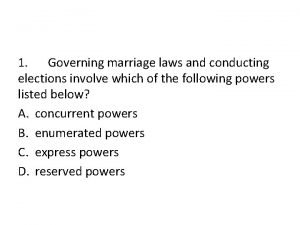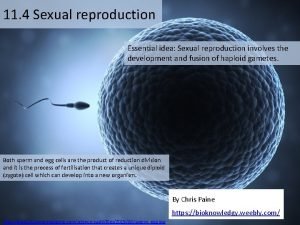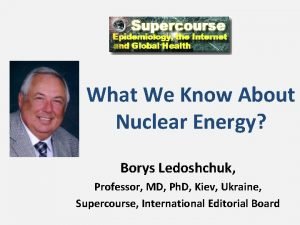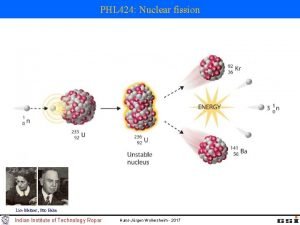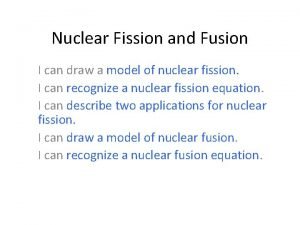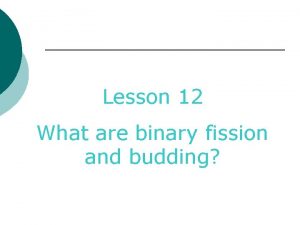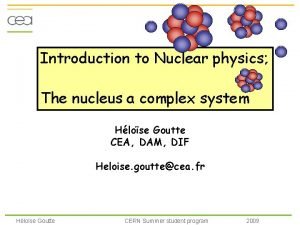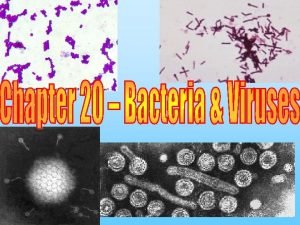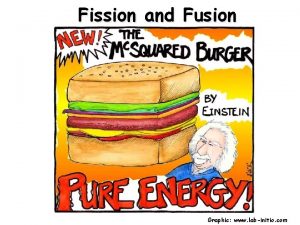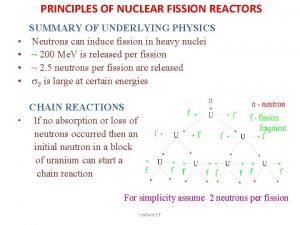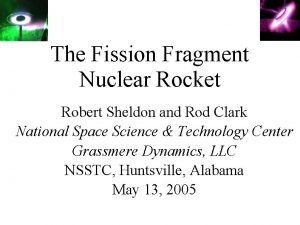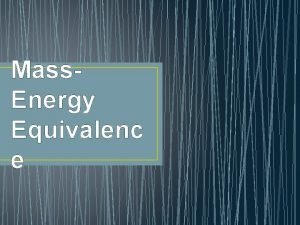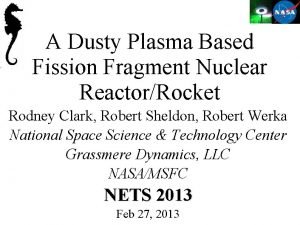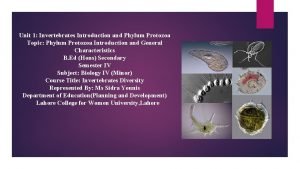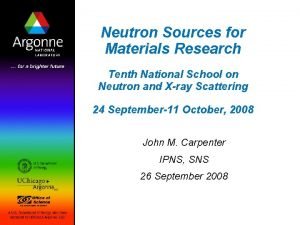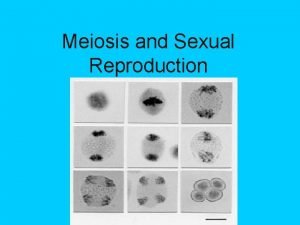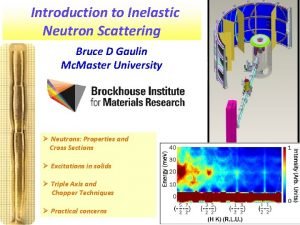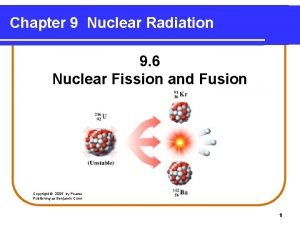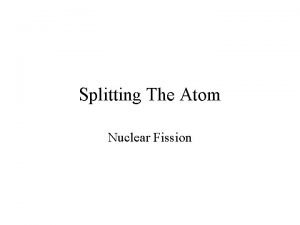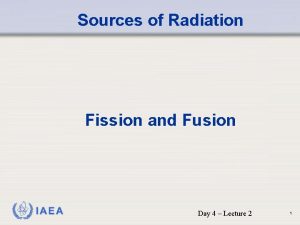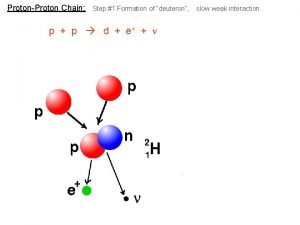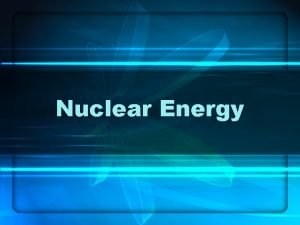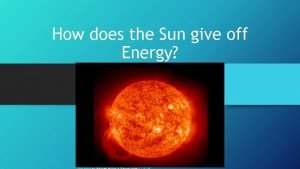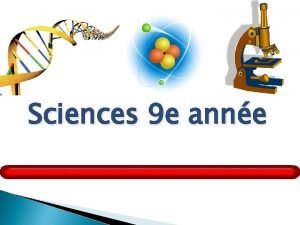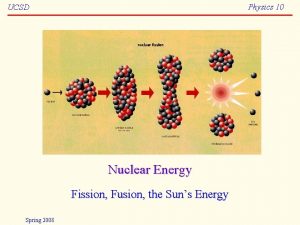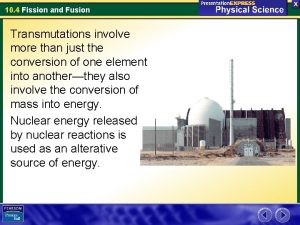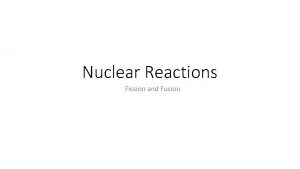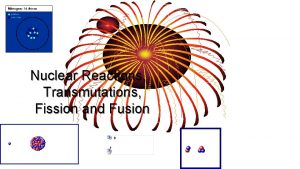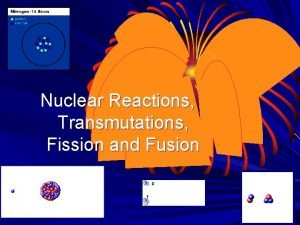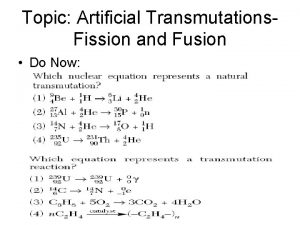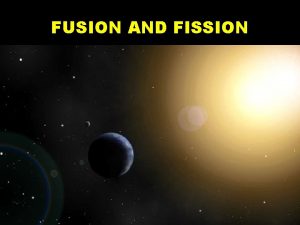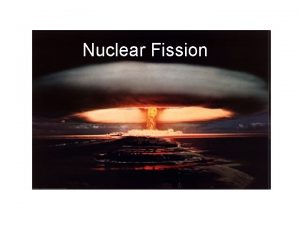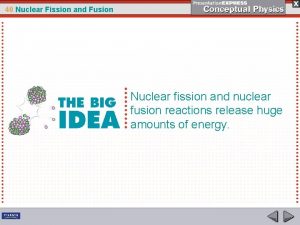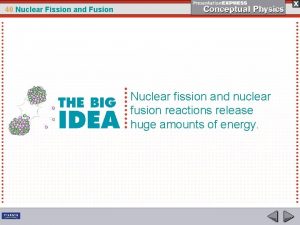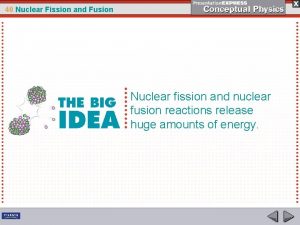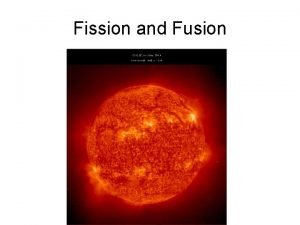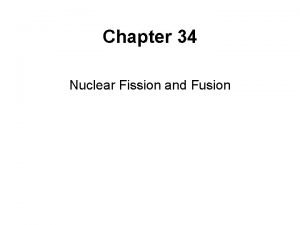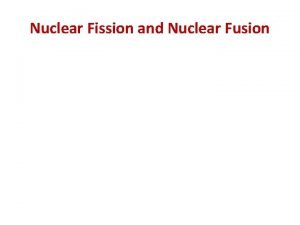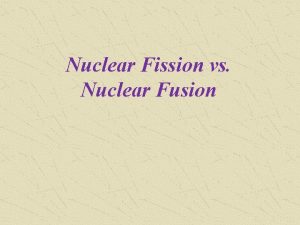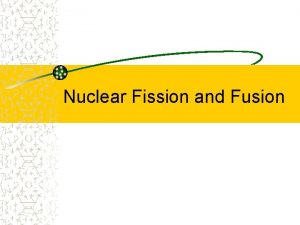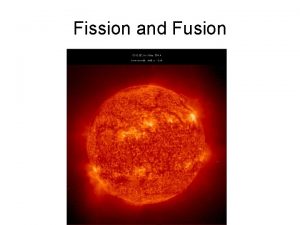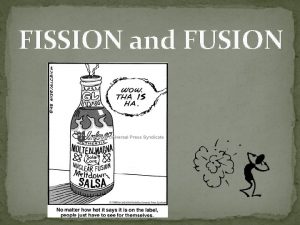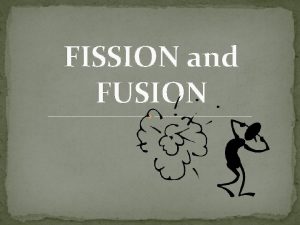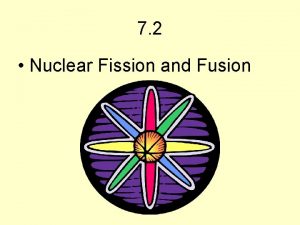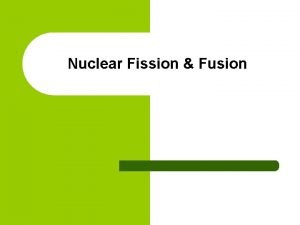10 4 Fission and Fusion Transmutations involve more





















































- Slides: 53

10. 4 Fission and Fusion Transmutations involve more than just the conversion of one element into another—they also involve the conversion of mass into energy. Nuclear energy released by nuclear reactions is used as an alterative source of energy.

10. 4 Fission and Fusion Nuclear Forces Under what conditions does the strong nuclear force overcome electric forces in the nucleus?

10. 4 Fission and Fusion Nuclear Forces The strong nuclear force is the attractive force that binds protons and neutrons together in the nucleus. Over very short distances, the strong nuclear force is much greater than the electric forces among protons.

10. 4 Fission and Fusion Nuclear Forces The protons in the nucleus are all positively charged, so they tend to repel one another. The strong nuclear force binds protons and neutrons together in the nucleus. • The strong nuclear force does not depend on charge. • It acts among protons, among neutrons, and among protons and neutrons.

10. 4 Fission and Fusion Nuclear Forces At the distance of a proton width, the strong nuclear force is more than 100 times greater than the electric force that repels protons. The strong nuclear force quickly weakens as protons and neutrons get farther apart.

10. 4 Fission and Fusion Nuclear Forces Strong nuclear forces and electric forces act upon particles in the nucleus. Strong Nuclear Forces Neutron Proton Electric Forces Neutron Proton

10. 4 Fission and Fusion Nuclear Forces The Effect of Size on Nuclear Forces The greater the number of protons in a nucleus, the greater is the electric force that repels those protons. The more protons and neutrons in a nucleus, the more possibilities there are for strong nuclear force attractions. Because the strong nuclear force only acts over short ranges, the possibility of many attractions is never realized in a large nucleus.

10. 4 Fission and Fusion Nuclear Forces A. The strong nuclear forces easily overcome the electric force between the protons. B. The larger number of electric forces makes the nucleus less stable. Nuclear Forces Acting on a Proton of a Small Nucleus Nuclear Forces Acting on a Proton of a Large Nucleus

10. 4 Fission and Fusion Nuclear Forces Unstable Nuclei A nucleus becomes unstable, or radioactive, when the strong nuclear force can no longer overcome the repulsive electric forces among protons. While the strong nuclear force does not increase with the size of the nucleus, the electric forces do. All nuclei with more than 83 protons are radioactive.

10. 4 Fission and Fusion Fission What property of fission makes it so useful? Fission is the splitting of an atomic nucleus into two smaller parts. In nuclear fission, tremendous amounts of energy can be produced from very small amounts of mass.

10. 4 Fission and Fusion Fission In 1938, Otto Hahn and Fritz Strassman bombarded uranium-235 with high-energy neutrons to produce more massive elements. Their experiments instead produced isotopes of a smaller element, barium. Lise Meitner and Otto Frisch determined that uranium-235 nuclei had been broken into smaller fragments.

10. 4 Fission and Fusion Fission Meitner predicted that fission releases energy. The nuclear energy released by the fission of 1 kilogram of uranium-235 is equivalent to the chemical energy produced by burning more than 17, 000 kilograms of coal.

10. 4 Fission and Fusion Fission The fission of uranium-235 yields smaller nuclei, neutrons, and energy. Neutron

10. 4 Fission and Fusion Fission The fission of uranium-235 yields smaller nuclei, neutrons, and energy. Neutron

10. 4 Fission and Fusion Fission The fission of uranium-235 yields smaller nuclei, neutrons, and energy. Neutron

10. 4 Fission and Fusion Fission The fission of uranium-235 yields smaller nuclei, neutrons, and energy. Neutron Energy

10. 4 Fission and Fusion Fission Converting Mass Into Energy When the fission of uranium-235 is carried out, about 0. 1 percent of the mass of the reactants is lost during the reaction. This “lost” mass is converted into energy. In 1905, Albert Einstein had introduced the mass-energy equation.

10. 4 Fission and Fusion Fission E represents energy, m represents mass, and c represents the speed of light (3. 0 × 108 m/s). • The conversion of a small amount of mass releases an enormous amount of energy. • According to the law of conservation of mass and energy, the total amount of mass and energy remains constant.

10. 4 Fission and Fusion Fission Triggering a Chain Reaction A uranium-235 nucleus decays into two smaller nuclei and releases two or three neutrons. If one of the neutrons is absorbed by another uranium-235 nucleus, another fission can result. In a chain reaction, neutrons released during the splitting of an initial nucleus trigger a series of nuclear fissions.

10. 4 Fission and Fusion Fission The fission of one nucleus can trigger a chain reaction.

10. 4 Fission and Fusion Fission In an uncontrolled chain reaction, all of the released neutrons are free to cause other fissions. • The result is a fast, intense release of energy. • Nuclear weapons are designed to produce uncontrolled chain reactions.

10. 4 Fission and Fusion Fission In a controlled chain reaction, some of the neutrons are absorbed by other materials resulting in only one new fission for each splitting of an atom. The heat from controlled chain reactions can be used to generate electrical energy.

10. 4 Fission and Fusion Fission In order to sustain a chain reaction, each nucleus that is split must produce, on average, one neutron that causes the fission of another nucleus. This condition corresponds to a specific mass of fissionable material. A critical mass is the smallest possible mass of a fissionable material that can sustain a chain reaction.

10. 4 Fission and Fusion Fission Nuclear Energy from Fission Nuclear power plants generate about 20 percent of the electricity in the United States. In a nuclear power plant, controlled fission of uranium-235 occurs in a vessel called a fission reactor. Nuclear power plants do not emit air pollutants.

10. 4 Fission and Fusion Fission Nuclear power plants do have safety and environmental issues. • Workers in nuclear power plants need to wear protective clothing to reduce their exposure to nuclear radiation. • Nuclear power produces radioactive isotopes with halflives of hundreds or thousands of years.

10. 4 Fission and Fusion Fission Unfortunately, a product of controlled chain reactions is radioactive waste. A crane lowers drums of radioactive waste into a landfill in Hanford, Washington.

10. 4 Fission and Fusion is a process in which the nuclei of two atoms combine to form a larger nucleus. As in fission, during fusion a small fraction of the reactant mass is converted into energy.

10. 4 Fission and Fusion The sun and other stars are powered by the fusion of hydrogen into helium. Inside the sun, an estimated 600 million tons of hydrogen undergo fusion each second. • Fusion requires extremely high temperatures. • Inside the sun, matter exists as plasma, a state of matter in which atoms have been stripped of their electrons.

10. 4 Fission and Fusion Scientists envision fusion reactors fueled by two hydrogen isotopes, deuterium (hydrogen-2) and tritium (hydrogen-3). The fusion of deuterium and tritium produces helium, neutrons, and energy. Two main problems in designing a fusion reactor are achieving the high temperatures required and containing the plasma.

10. 4 Fission and Fusion The Tokamak Fusion Test Reactor at the Princeton Plasma Physics Laboratory was one of the very few fusion reactors that have been built.

10. 4 Fission and Fusion RADIOACTIVE ISOTOPE HALF-LIVES © 2012 JOHN WILEY & SONS, INC. ALL RIGHTS RESERVED.

10. 4 Fission and Fusion PROS AND CONS OF NUCLEAR ENERGY Pros Less of an immediate environmental impact compared to fossil fuels Carbon-free source of electricity May be able to generate H-fuel Cons Generates radioactive waste Many steps require fossil fuels (mining and disposal) Expensive © 2012 JOHN WILEY & SONS, INC. ALL RIGHTS RESERVED.

10. 4 Fission and Fusion SAFETY ISSUES IN NUCLEAR POWER PLANTS Meltdown At high temperatures the metal encasing the uranium fuel can melt, releasing radiation Probability of meltdown is low Public perception is that nuclear power is not safe Sites of major accidents: Three Mile Island, PA Chernobyl, Ukraine Fukushima Daiichi, Japan © 2012 JOHN WILEY & SONS, INC. ALL RIGHTS RESERVED.

10. 4 Fission and Fusion THREE-MILE ISLAND 1979 - most serious reactor accident in US 50% meltdown of reactor core Containment building kept radiation from escaping No substantial environmental damage No human casualties 12 years and 1 billion dollars to repair Elevated public fear of nuclear energy Led to cancellation of many new plants in US © 2012 JOHN WILEY & SONS, INC. ALL RIGHTS RESERVED.

10. 4 Fission and Fusion CHERNOBYL 1986 - worst accident in history 1 or 2 explosions destroyed the nuclear reactor Large amounts of radiation escaped into atmosphere Spread across large portions of Europe © 2012 JOHN WILEY & SONS, INC. ALL RIGHTS RESERVED.

10. 4 Fission and Fusion CHERNOBYL Radiation spread was unpredictable and uneven 4, 000 deaths attributed to plant explosion Mostly due to cancer © 2012 JOHN WILEY & SONS, INC. ALL RIGHTS RESERVED.

10. 4 Fission and Fusion FUKUSHIMA DAIICHI March 11, 2011 - caused by magnitude 9. 0 earthquake and ensuing tsunami Disrupted power systems that pump cooling water to reactor cores and spent fuel rods Increased radiation in local water and food supplies May limit seafood catches for decades © 2012 JOHN WILEY & SONS, INC. ALL RIGHTS RESERVED.

10. 4 Fission and Fusion FUKUSHIMA DAIICHI © 2012 JOHN WILEY & SONS, INC. ALL RIGHTS RESERVED.

10. 4 Fission and Fusion NUCLEAR ENERGY AND NUCLEAR WEAPONS 31 countries use nuclear energy to create electricity These countries have access to materials needed to produce enriched plutonium or uranium for nuclear weapons Safe storage and handling of these weapons is a concern © 2012 JOHN WILEY & SONS, INC. ALL RIGHTS RESERVED.

10. 4 Fission and Fusion RADIOACTIVE WASTE Low level radioactive waste Radioactive solids, liquids or gases that give off small amounts of ionizing radiation Produced by power plants, research labs, hospitals and industry High-level radioactive waste Radioactive solids liquids or gases that give off large amounts of ionizing radiation Primarily spent fuel rods and assemblies © 2012 JOHN WILEY & SONS, INC. ALL RIGHTS RESERVED.

10. 4 Fission and Fusion RADIOACTIVE WASTE Temporary storage solutions In nuclear plant facility (require high security) Under water storage Above ground concrete and steel casks Need approved permanent options soon. © 2012 JOHN WILEY & SONS, INC. ALL RIGHTS RESERVED.

10. 4 Fission and Fusion CASE-IN-POINT YUCCA MOUNTAIN 70, 000 tons of high-level radioactive waste Tectonic issues have been identified © 2012 JOHN WILEY & SONS, INC. ALL RIGHTS RESERVED.

10. 4 Fission and Fusion DECOMMISSIONING NUCLEAR POWER PLANTS Licensed to operate for 40 years Several have received 20 -year extensions Power plants cannot be abandoned when they are shut down Three solutions Storage Entombment Decommissioning (dismantling)- best option 110 power plants were retired as of 2010 © 2012 JOHN WILEY & SONS, INC. ALL RIGHTS RESERVED.

10. 4 Fission and Fusion ATTITUDES TOWARDS NUCLEAR POWER Generally a major case of mistrust on the part of the public towards pro -nuclear power scientists and politicians NIMBY- Not In My Back. Yard Citizens to not want a nuclear facility or waste disposal site near their home Dad- Decide, Announce, Defend Pronuclear advocates Based on the science, not fears © 2012 JOHN WILEY & SONS, INC. ALL RIGHTS RESERVED.

10. 4 Fission and Fusion FUSION Way of the future? Produces no high-level waste Fuel is hydrogen Problems It takes very high temperatures (millions of degrees) to make atoms fuse Confining the plasma after it is formed Scientists have yet to be able to create energy from fusion © 2012 JOHN WILEY & SONS, INC. ALL RIGHTS RESERVED.

10. 4 Fission and Fusion Assessment Questions 1. Why do nuclei become less stable as the atomic number increases? a. The strong nuclear forces become too strong and expel particles. b. The strong nuclear forces become weaker and cannot overcome electrical forces. c. The electrical forces become stronger and overcome strong nuclear forces. d. The electron cloud becomes too large and increases pressure on the nucleus.

10. 4 Fission and Fusion Assessment Questions 1. Why do nuclei become less stable as the atomic number increases? a. The strong nuclear forces become too strong and expel particles. b. The strong nuclear forces become weaker and cannot overcome electrical forces. c. The electrical forces become stronger and overcome strong nuclear forces. d. The electron cloud becomes too large and increases pressure on the nucleus. ANS: C

10. 4 Fission and Fusion Assessment Questions 2. Which of the following statements about nuclear fission is false? a. Fission is the splitting of a nucleus into two smaller parts. b. Fission produces tremendous amounts of energy from a small mass. c. Mass is conserved during nuclear fission. d. Fission does not always yield the same products.

10. 4 Fission and Fusion Assessment Questions 2. Which of the following statements about nuclear fission is false? a. Fission is the splitting of a nucleus into two smaller parts. b. Fission produces tremendous amounts of energy from a small mass. c. Mass is conserved during nuclear fission. d. Fission does not always yield the same products. ANS: C

10. 4 Fission and Fusion Assessment Questions 3. How is nuclear energy converted to electrical energy in a nuclear power plant? a. Nuclear fusion releases electrons that then flow through wires. b. Fission reactions in the core of the reactor release charged particles that form the current. c. A fission reaction produces energy as heat, which converts water to steam that drives a turbine connected to a generator. d. Neutrons from the nuclear fission process drive a turbine that is connected to a generator.

10. 4 Fission and Fusion Assessment Questions 3. How is nuclear energy converted to electrical energy in a nuclear power plant? a. Nuclear fusion releases electrons that then flow through wires. b. Fission reactions in the core of the reactor release charged particles that form the current. c. A fission reaction produces energy as heat, which converts water to steam that drives a turbine connected to a generator. d. Neutrons from the nuclear fission process drive a turbine that is connected to a generator. ANS: C

10. 4 Fission and Fusion Assessment Questions 4. Why has nuclear fusion not been used to produce power on Earth. a. Fusion only occurs in high temperature plasmas, which cannot yet be controlled. b. Nuclear fusion requires deuterium, which is not available on Earth. c. Fusion does not produce enough energy to justify its use. d. Scientists do not yet know how to start a fusion reaction.

10. 4 Fission and Fusion Assessment Questions 4. Why has nuclear fusion not been used to produce power on Earth. a. Fusion only occurs in high temperature plasmas, which cannot yet be controlled. b. Nuclear fusion requires deuterium, which is not available on Earth. c. Fusion does not produce enough energy to justify its use. d. Scientists do not yet know how to start a fusion reaction. ANS: A
 More more more i want more more more more we praise you
More more more i want more more more more we praise you More more more i want more more more more we praise you
More more more i want more more more more we praise you Fusion or fission
Fusion or fission Natural transmutation example
Natural transmutation example Fussion vs fission
Fussion vs fission Nuclear fission and fusion similarities
Nuclear fission and fusion similarities Sun fission
Sun fission Fussion vs fission
Fussion vs fission Fission and fusion similarities
Fission and fusion similarities Fission vs fusion
Fission vs fusion Who discovered radioactivity
Who discovered radioactivity Fission vs fusion
Fission vs fusion Fusion fission
Fusion fission Rds 37 bomb
Rds 37 bomb Fission vs fusion energy output
Fission vs fusion energy output Fusion or fission
Fusion or fission Human history becomes more and more a race
Human history becomes more and more a race Advantage and disadvantage of binary fission
Advantage and disadvantage of binary fission Governing marriage laws and conducting elections
Governing marriage laws and conducting elections Meiosis 1 spermatogenesis
Meiosis 1 spermatogenesis The more you take the more you leave behind
The more you take the more you leave behind The more you study the more you learn
The more you study the more you learn Aspire not to have more but to be more
Aspire not to have more but to be more Newton's law
Newton's law Knowing more remembering more
Knowing more remembering more More love to thee o lord
More love to thee o lord More choices more chances
More choices more chances Fission reactor nuclearcraft
Fission reactor nuclearcraft Types of asexual reproduction
Types of asexual reproduction Nuclear fission lise meitner
Nuclear fission lise meitner U 235 fission products
U 235 fission products Application of nuclear fission
Application of nuclear fission Fission vs budding
Fission vs budding Spontaneous fission definition
Spontaneous fission definition Binary fission vs conjugation
Binary fission vs conjugation Fission equation
Fission equation Nuclear fission explanation
Nuclear fission explanation Transverse binary fission
Transverse binary fission Fission fragment rocket
Fission fragment rocket How does the mass-energy equation e= mc 2relate to fission?
How does the mass-energy equation e= mc 2relate to fission? Fission fragment rocket
Fission fragment rocket Protozoa invertebrates
Protozoa invertebrates Spallation neutron source
Spallation neutron source Advantages of binary fission
Advantages of binary fission Neutron fission
Neutron fission Nuclear fission radiation
Nuclear fission radiation Asexual reproduction cell division
Asexual reproduction cell division Pluotnium
Pluotnium Fission
Fission Nuclear fission
Nuclear fission Fission
Fission Nuclear fission formula
Nuclear fission formula Fission binaire et mitose
Fission binaire et mitose Nuclear fission
Nuclear fission


